Entrepreneurial Orientation and SME Performance in Nigeria
VerifiedAdded on 2019/09/20
|20
|5203
|299
Essay
AI Summary
The provided assignment content focuses on various business-related articles and books that explore themes such as strategic management, entrepreneurial orientation, government support policy, and corporate sustainability management. The content includes works by Adewumi, Teece et al., Bijaoui, Ajayi, Zoogah et al., Ibrahim et al., Peng, Ali, Baumgartner & Rauter, Brea-Solís et al., Chan & Huff, Cheong et al., Dell'Era et al., Elkington, Fransen et al., Genus et al., Goldman, Green, Kotabe & Murray, McAdam et al., and Walsh & Dodds. The articles discuss topics such as dynamic capabilities, strategic orientation, entrepreneurial orientation, government support policy, and corporate sustainability management.
Contribute Materials
Your contribution can guide someone’s learning journey. Share your
documents today.
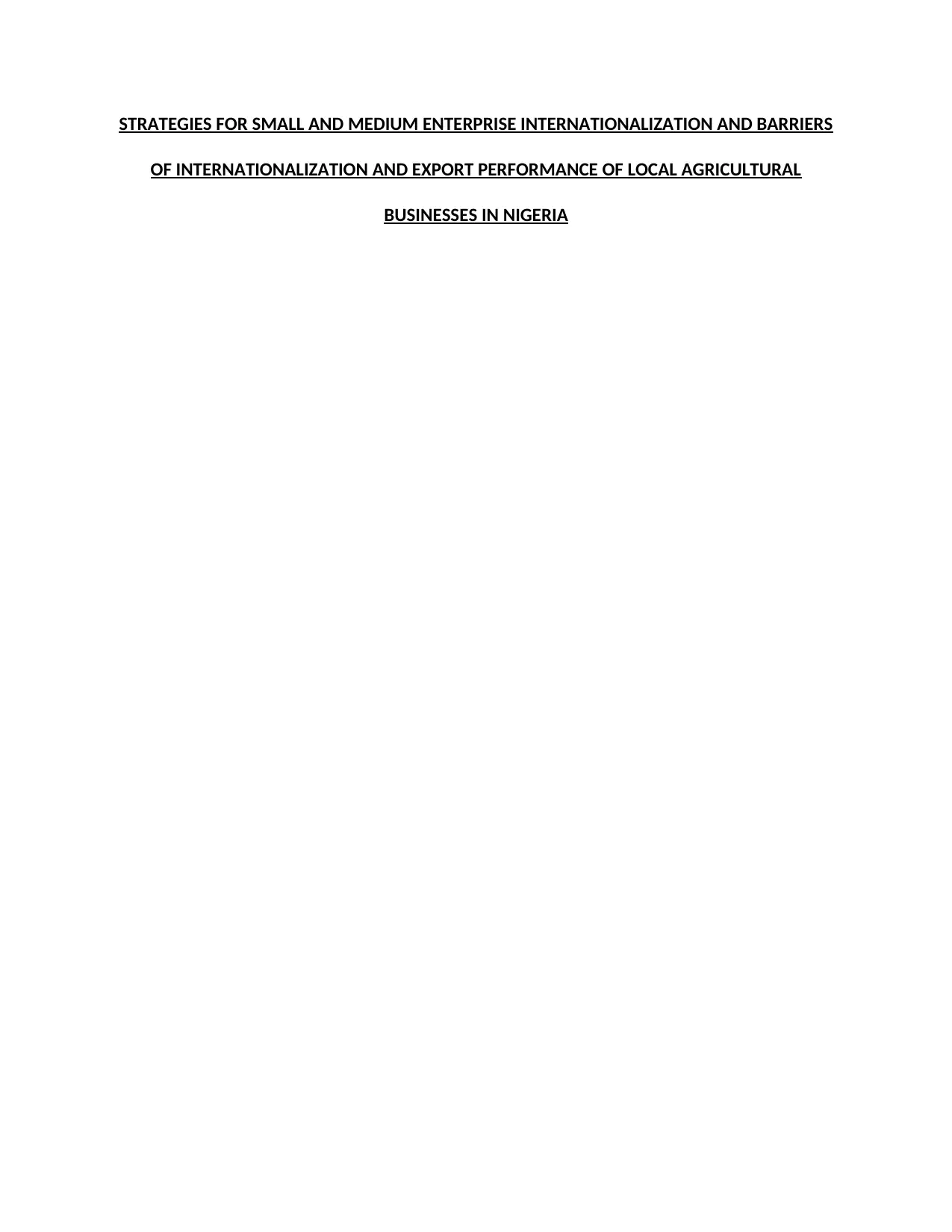
STRATEGIES FOR SMALL AND MEDIUM ENTERPRISE INTERNATIONALIZATION AND BARRIERS
OF INTERNATIONALIZATION AND EXPORT PERFORMANCE OF LOCAL AGRICULTURAL
BUSINESSES IN NIGERIA
OF INTERNATIONALIZATION AND EXPORT PERFORMANCE OF LOCAL AGRICULTURAL
BUSINESSES IN NIGERIA
Secure Best Marks with AI Grader
Need help grading? Try our AI Grader for instant feedback on your assignments.
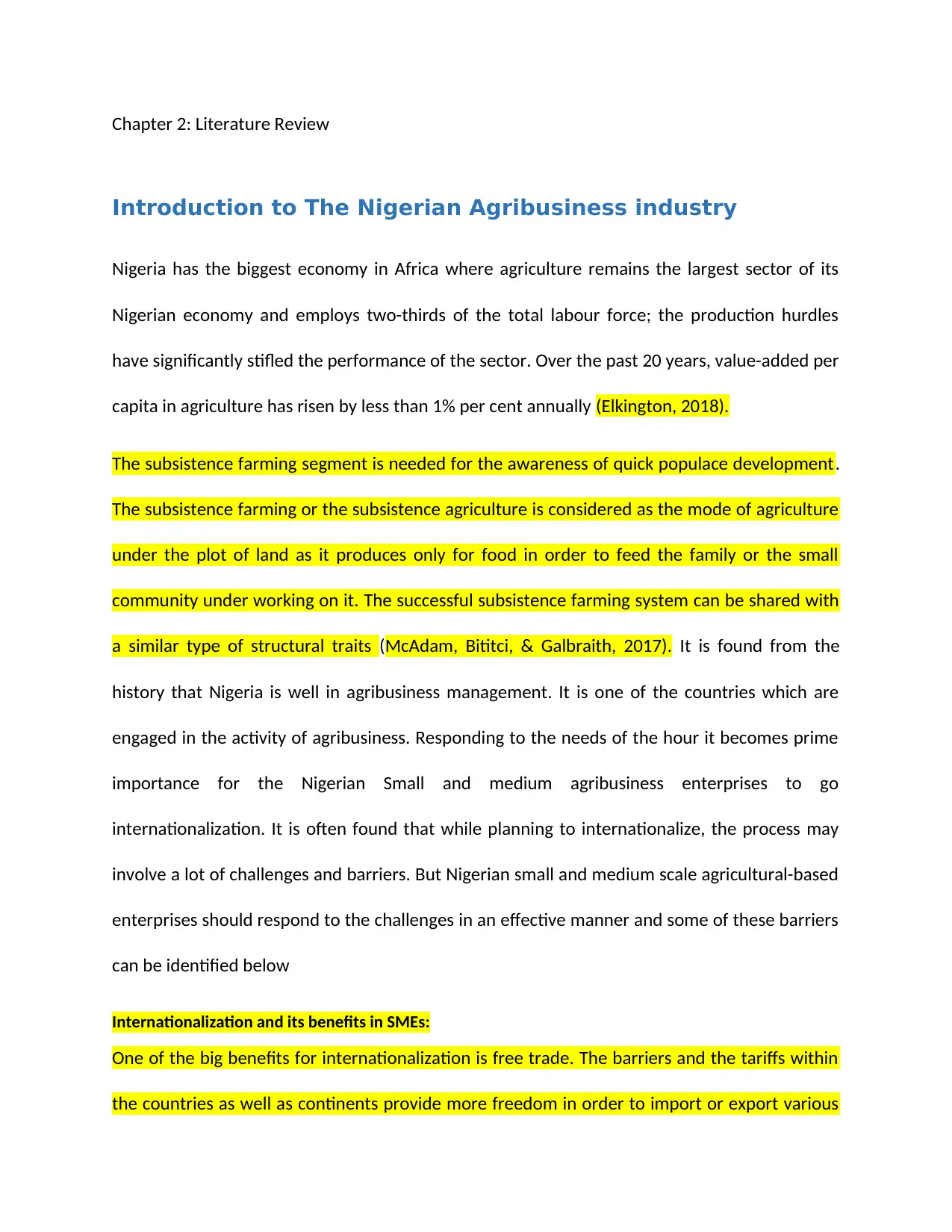
Chapter 2: Literature Review
Introduction to The Nigerian Agribusiness industry
Nigeria has the biggest economy in Africa where agriculture remains the largest sector of its
Nigerian economy and employs two-thirds of the total labour force; the production hurdles
have significantly stifled the performance of the sector. Over the past 20 years, value-added per
capita in agriculture has risen by less than 1% per cent annually (Elkington, 2018).
The subsistence farming segment is needed for the awareness of quick populace development.
The subsistence farming or the subsistence agriculture is considered as the mode of agriculture
under the plot of land as it produces only for food in order to feed the family or the small
community under working on it. The successful subsistence farming system can be shared with
a similar type of structural traits (McAdam, Bititci, & Galbraith, 2017). It is found from the
history that Nigeria is well in agribusiness management. It is one of the countries which are
engaged in the activity of agribusiness. Responding to the needs of the hour it becomes prime
importance for the Nigerian Small and medium agribusiness enterprises to go
internationalization. It is often found that while planning to internationalize, the process may
involve a lot of challenges and barriers. But Nigerian small and medium scale agricultural-based
enterprises should respond to the challenges in an effective manner and some of these barriers
can be identified below
Internationalization and its benefits in SMEs:
One of the big benefits for internationalization is free trade. The barriers and the tariffs within
the countries as well as continents provide more freedom in order to import or export various
Introduction to The Nigerian Agribusiness industry
Nigeria has the biggest economy in Africa where agriculture remains the largest sector of its
Nigerian economy and employs two-thirds of the total labour force; the production hurdles
have significantly stifled the performance of the sector. Over the past 20 years, value-added per
capita in agriculture has risen by less than 1% per cent annually (Elkington, 2018).
The subsistence farming segment is needed for the awareness of quick populace development.
The subsistence farming or the subsistence agriculture is considered as the mode of agriculture
under the plot of land as it produces only for food in order to feed the family or the small
community under working on it. The successful subsistence farming system can be shared with
a similar type of structural traits (McAdam, Bititci, & Galbraith, 2017). It is found from the
history that Nigeria is well in agribusiness management. It is one of the countries which are
engaged in the activity of agribusiness. Responding to the needs of the hour it becomes prime
importance for the Nigerian Small and medium agribusiness enterprises to go
internationalization. It is often found that while planning to internationalize, the process may
involve a lot of challenges and barriers. But Nigerian small and medium scale agricultural-based
enterprises should respond to the challenges in an effective manner and some of these barriers
can be identified below
Internationalization and its benefits in SMEs:
One of the big benefits for internationalization is free trade. The barriers and the tariffs within
the countries as well as continents provide more freedom in order to import or export various
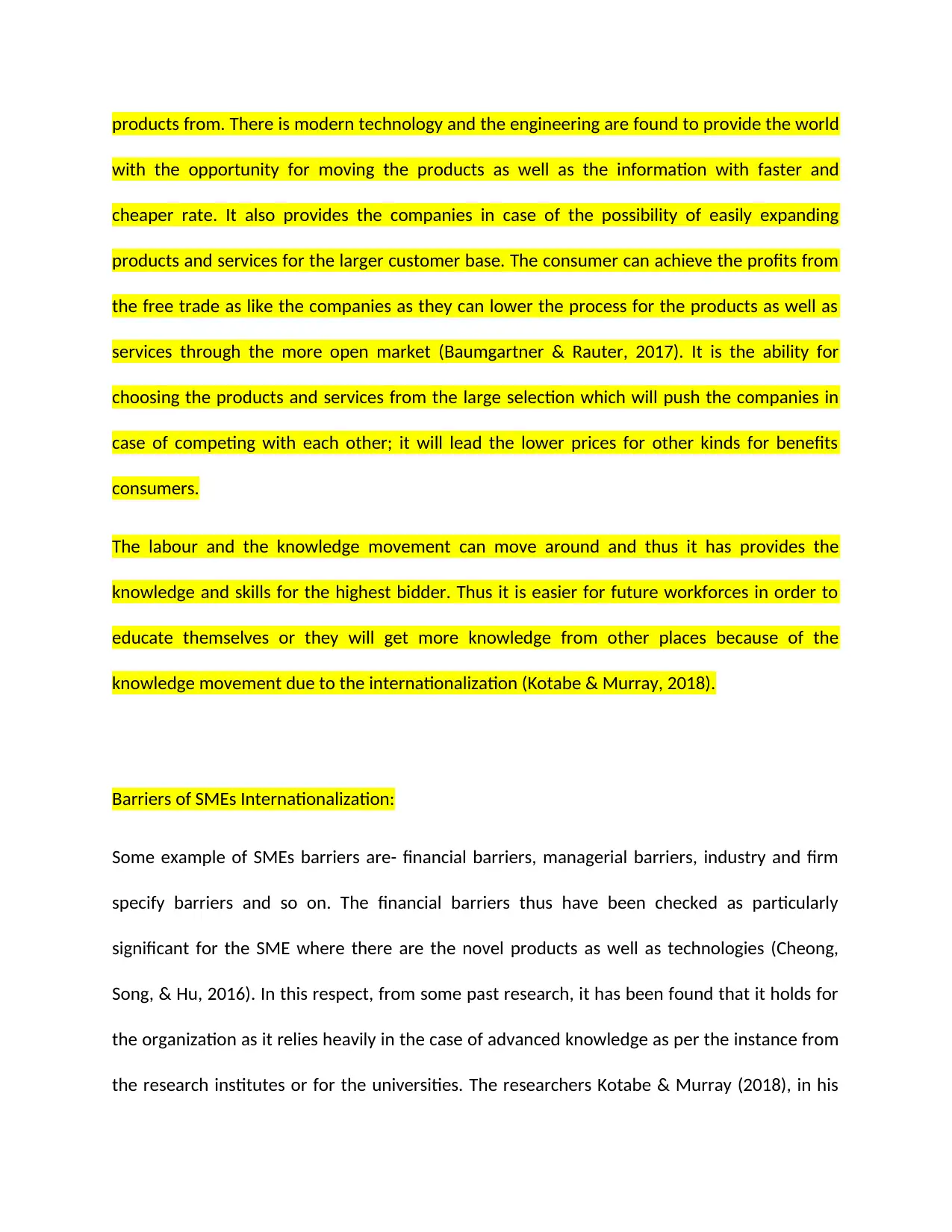
products from. There is modern technology and the engineering are found to provide the world
with the opportunity for moving the products as well as the information with faster and
cheaper rate. It also provides the companies in case of the possibility of easily expanding
products and services for the larger customer base. The consumer can achieve the profits from
the free trade as like the companies as they can lower the process for the products as well as
services through the more open market (Baumgartner & Rauter, 2017). It is the ability for
choosing the products and services from the large selection which will push the companies in
case of competing with each other; it will lead the lower prices for other kinds for benefits
consumers.
The labour and the knowledge movement can move around and thus it has provides the
knowledge and skills for the highest bidder. Thus it is easier for future workforces in order to
educate themselves or they will get more knowledge from other places because of the
knowledge movement due to the internationalization (Kotabe & Murray, 2018).
Barriers of SMEs Internationalization:
Some example of SMEs barriers are- financial barriers, managerial barriers, industry and firm
specify barriers and so on. The financial barriers thus have been checked as particularly
significant for the SME where there are the novel products as well as technologies (Cheong,
Song, & Hu, 2016). In this respect, from some past research, it has been found that it holds for
the organization as it relies heavily in the case of advanced knowledge as per the instance from
the research institutes or for the universities. The researchers Kotabe & Murray (2018), in his
with the opportunity for moving the products as well as the information with faster and
cheaper rate. It also provides the companies in case of the possibility of easily expanding
products and services for the larger customer base. The consumer can achieve the profits from
the free trade as like the companies as they can lower the process for the products as well as
services through the more open market (Baumgartner & Rauter, 2017). It is the ability for
choosing the products and services from the large selection which will push the companies in
case of competing with each other; it will lead the lower prices for other kinds for benefits
consumers.
The labour and the knowledge movement can move around and thus it has provides the
knowledge and skills for the highest bidder. Thus it is easier for future workforces in order to
educate themselves or they will get more knowledge from other places because of the
knowledge movement due to the internationalization (Kotabe & Murray, 2018).
Barriers of SMEs Internationalization:
Some example of SMEs barriers are- financial barriers, managerial barriers, industry and firm
specify barriers and so on. The financial barriers thus have been checked as particularly
significant for the SME where there are the novel products as well as technologies (Cheong,
Song, & Hu, 2016). In this respect, from some past research, it has been found that it holds for
the organization as it relies heavily in the case of advanced knowledge as per the instance from
the research institutes or for the universities. The researchers Kotabe & Murray (2018), in his
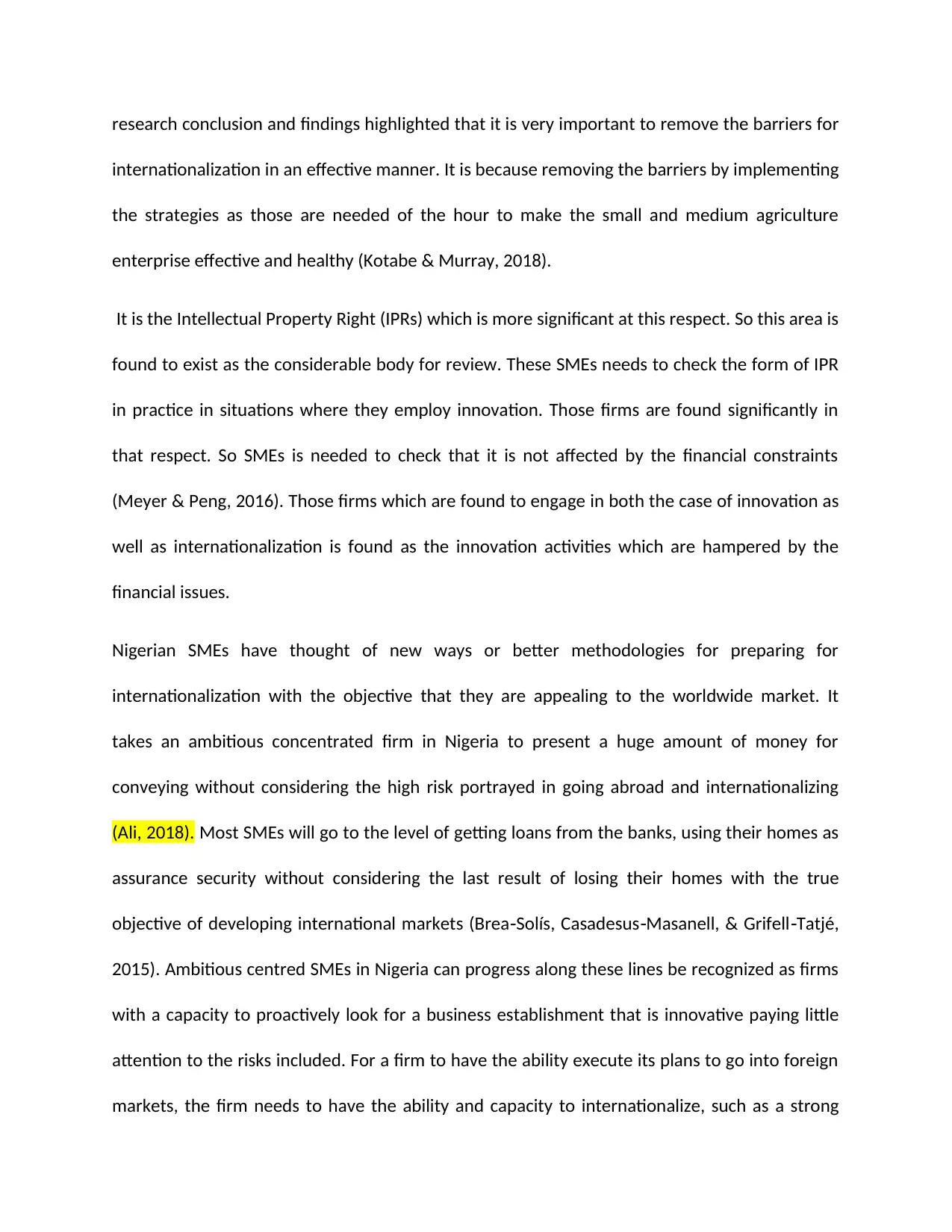
research conclusion and findings highlighted that it is very important to remove the barriers for
internationalization in an effective manner. It is because removing the barriers by implementing
the strategies as those are needed of the hour to make the small and medium agriculture
enterprise effective and healthy (Kotabe & Murray, 2018).
It is the Intellectual Property Right (IPRs) which is more significant at this respect. So this area is
found to exist as the considerable body for review. These SMEs needs to check the form of IPR
in practice in situations where they employ innovation. Those firms are found significantly in
that respect. So SMEs is needed to check that it is not affected by the financial constraints
(Meyer & Peng, 2016). Those firms which are found to engage in both the case of innovation as
well as internationalization is found as the innovation activities which are hampered by the
financial issues.
Nigerian SMEs have thought of new ways or better methodologies for preparing for
internationalization with the objective that they are appealing to the worldwide market. It
takes an ambitious concentrated firm in Nigeria to present a huge amount of money for
conveying without considering the high risk portrayed in going abroad and internationalizing
(Ali, 2018). Most SMEs will go to the level of getting loans from the banks, using their homes as
assurance security without considering the last result of losing their homes with the true
objective of developing international markets (Brea Solís, Casadesus Masanell, & Grifell Tatjé,‐ ‐ ‐
2015). Ambitious centred SMEs in Nigeria can progress along these lines be recognized as firms
with a capacity to proactively look for a business establishment that is innovative paying little
attention to the risks included. For a firm to have the ability execute its plans to go into foreign
markets, the firm needs to have the ability and capacity to internationalize, such as a strong
internationalization in an effective manner. It is because removing the barriers by implementing
the strategies as those are needed of the hour to make the small and medium agriculture
enterprise effective and healthy (Kotabe & Murray, 2018).
It is the Intellectual Property Right (IPRs) which is more significant at this respect. So this area is
found to exist as the considerable body for review. These SMEs needs to check the form of IPR
in practice in situations where they employ innovation. Those firms are found significantly in
that respect. So SMEs is needed to check that it is not affected by the financial constraints
(Meyer & Peng, 2016). Those firms which are found to engage in both the case of innovation as
well as internationalization is found as the innovation activities which are hampered by the
financial issues.
Nigerian SMEs have thought of new ways or better methodologies for preparing for
internationalization with the objective that they are appealing to the worldwide market. It
takes an ambitious concentrated firm in Nigeria to present a huge amount of money for
conveying without considering the high risk portrayed in going abroad and internationalizing
(Ali, 2018). Most SMEs will go to the level of getting loans from the banks, using their homes as
assurance security without considering the last result of losing their homes with the true
objective of developing international markets (Brea Solís, Casadesus Masanell, & Grifell Tatjé,‐ ‐ ‐
2015). Ambitious centred SMEs in Nigeria can progress along these lines be recognized as firms
with a capacity to proactively look for a business establishment that is innovative paying little
attention to the risks included. For a firm to have the ability execute its plans to go into foreign
markets, the firm needs to have the ability and capacity to internationalize, such as a strong
Paraphrase This Document
Need a fresh take? Get an instant paraphrase of this document with our AI Paraphraser
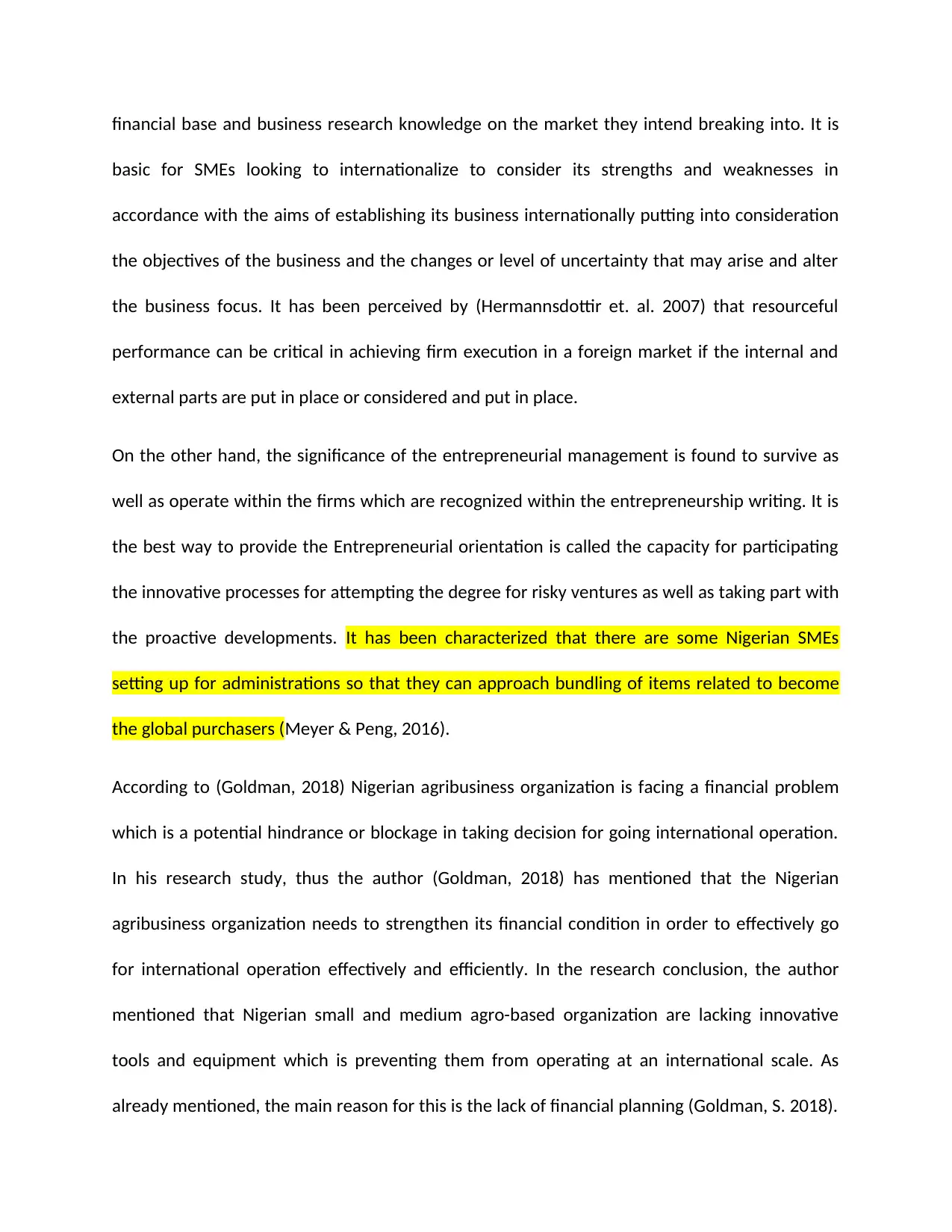
financial base and business research knowledge on the market they intend breaking into. It is
basic for SMEs looking to internationalize to consider its strengths and weaknesses in
accordance with the aims of establishing its business internationally putting into consideration
the objectives of the business and the changes or level of uncertainty that may arise and alter
the business focus. It has been perceived by (Hermannsdottir et. al. 2007) that resourceful
performance can be critical in achieving firm execution in a foreign market if the internal and
external parts are put in place or considered and put in place.
On the other hand, the significance of the entrepreneurial management is found to survive as
well as operate within the firms which are recognized within the entrepreneurship writing. It is
the best way to provide the Entrepreneurial orientation is called the capacity for participating
the innovative processes for attempting the degree for risky ventures as well as taking part with
the proactive developments. It has been characterized that there are some Nigerian SMEs
setting up for administrations so that they can approach bundling of items related to become
the global purchasers (Meyer & Peng, 2016).
According to (Goldman, 2018) Nigerian agribusiness organization is facing a financial problem
which is a potential hindrance or blockage in taking decision for going international operation.
In his research study, thus the author (Goldman, 2018) has mentioned that the Nigerian
agribusiness organization needs to strengthen its financial condition in order to effectively go
for international operation effectively and efficiently. In the research conclusion, the author
mentioned that Nigerian small and medium agro-based organization are lacking innovative
tools and equipment which is preventing them from operating at an international scale. As
already mentioned, the main reason for this is the lack of financial planning (Goldman, S. 2018).
basic for SMEs looking to internationalize to consider its strengths and weaknesses in
accordance with the aims of establishing its business internationally putting into consideration
the objectives of the business and the changes or level of uncertainty that may arise and alter
the business focus. It has been perceived by (Hermannsdottir et. al. 2007) that resourceful
performance can be critical in achieving firm execution in a foreign market if the internal and
external parts are put in place or considered and put in place.
On the other hand, the significance of the entrepreneurial management is found to survive as
well as operate within the firms which are recognized within the entrepreneurship writing. It is
the best way to provide the Entrepreneurial orientation is called the capacity for participating
the innovative processes for attempting the degree for risky ventures as well as taking part with
the proactive developments. It has been characterized that there are some Nigerian SMEs
setting up for administrations so that they can approach bundling of items related to become
the global purchasers (Meyer & Peng, 2016).
According to (Goldman, 2018) Nigerian agribusiness organization is facing a financial problem
which is a potential hindrance or blockage in taking decision for going international operation.
In his research study, thus the author (Goldman, 2018) has mentioned that the Nigerian
agribusiness organization needs to strengthen its financial condition in order to effectively go
for international operation effectively and efficiently. In the research conclusion, the author
mentioned that Nigerian small and medium agro-based organization are lacking innovative
tools and equipment which is preventing them from operating at an international scale. As
already mentioned, the main reason for this is the lack of financial planning (Goldman, S. 2018).
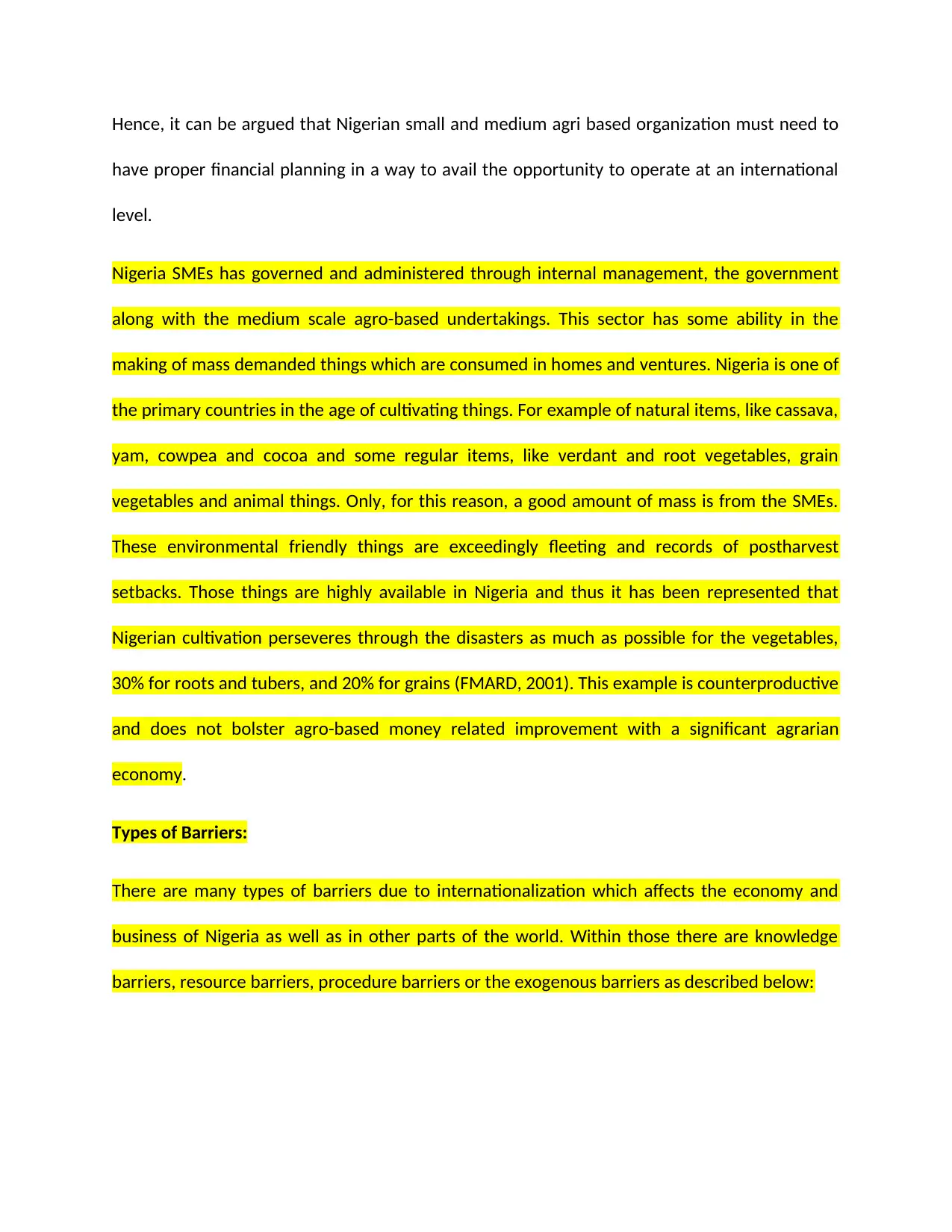
Hence, it can be argued that Nigerian small and medium agri based organization must need to
have proper financial planning in a way to avail the opportunity to operate at an international
level.
Nigeria SMEs has governed and administered through internal management, the government
along with the medium scale agro-based undertakings. This sector has some ability in the
making of mass demanded things which are consumed in homes and ventures. Nigeria is one of
the primary countries in the age of cultivating things. For example of natural items, like cassava,
yam, cowpea and cocoa and some regular items, like verdant and root vegetables, grain
vegetables and animal things. Only, for this reason, a good amount of mass is from the SMEs.
These environmental friendly things are exceedingly fleeting and records of postharvest
setbacks. Those things are highly available in Nigeria and thus it has been represented that
Nigerian cultivation perseveres through the disasters as much as possible for the vegetables,
30% for roots and tubers, and 20% for grains (FMARD, 2001). This example is counterproductive
and does not bolster agro-based money related improvement with a significant agrarian
economy.
Types of Barriers:
There are many types of barriers due to internationalization which affects the economy and
business of Nigeria as well as in other parts of the world. Within those there are knowledge
barriers, resource barriers, procedure barriers or the exogenous barriers as described below:
have proper financial planning in a way to avail the opportunity to operate at an international
level.
Nigeria SMEs has governed and administered through internal management, the government
along with the medium scale agro-based undertakings. This sector has some ability in the
making of mass demanded things which are consumed in homes and ventures. Nigeria is one of
the primary countries in the age of cultivating things. For example of natural items, like cassava,
yam, cowpea and cocoa and some regular items, like verdant and root vegetables, grain
vegetables and animal things. Only, for this reason, a good amount of mass is from the SMEs.
These environmental friendly things are exceedingly fleeting and records of postharvest
setbacks. Those things are highly available in Nigeria and thus it has been represented that
Nigerian cultivation perseveres through the disasters as much as possible for the vegetables,
30% for roots and tubers, and 20% for grains (FMARD, 2001). This example is counterproductive
and does not bolster agro-based money related improvement with a significant agrarian
economy.
Types of Barriers:
There are many types of barriers due to internationalization which affects the economy and
business of Nigeria as well as in other parts of the world. Within those there are knowledge
barriers, resource barriers, procedure barriers or the exogenous barriers as described below:
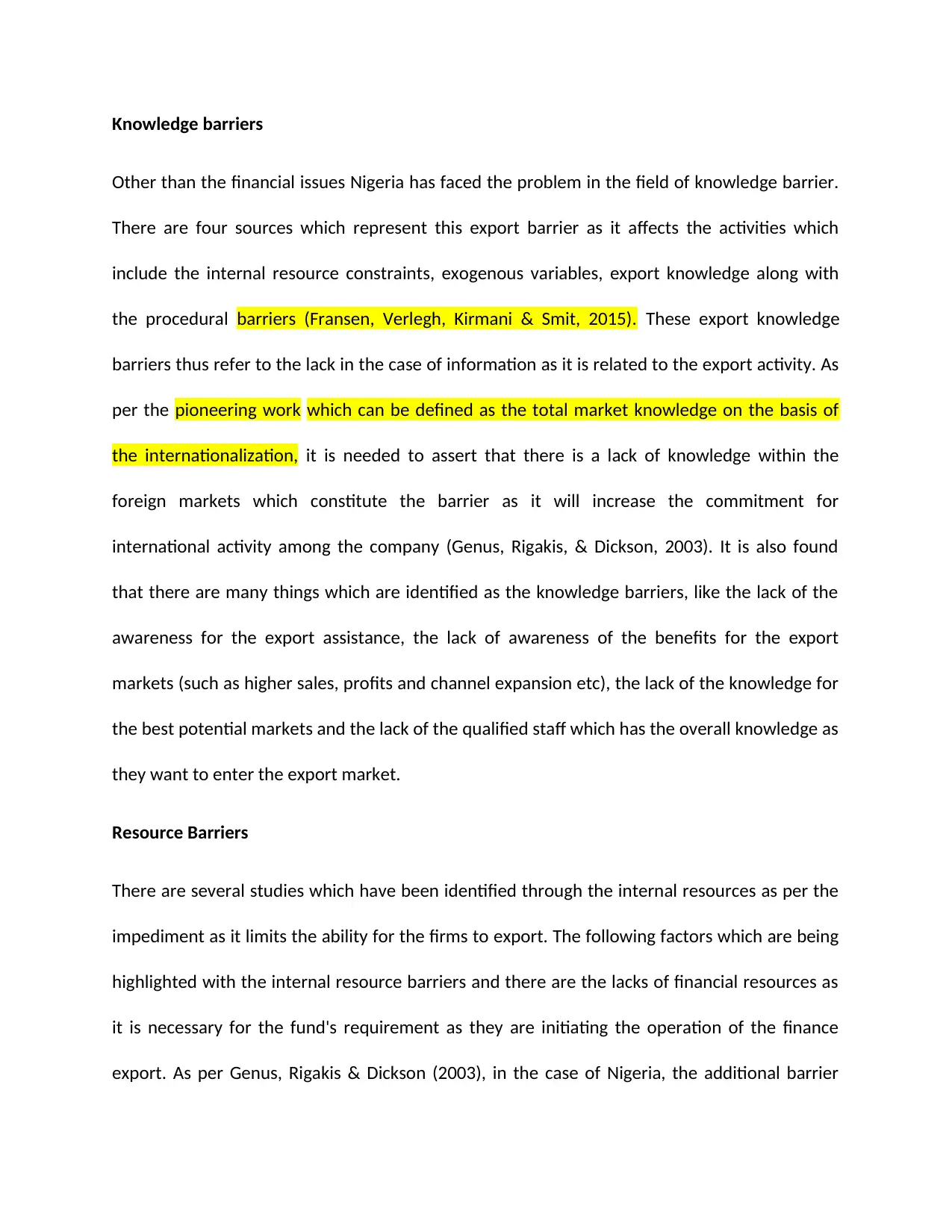
Knowledge barriers
Other than the financial issues Nigeria has faced the problem in the field of knowledge barrier.
There are four sources which represent this export barrier as it affects the activities which
include the internal resource constraints, exogenous variables, export knowledge along with
the procedural barriers (Fransen, Verlegh, Kirmani & Smit, 2015). These export knowledge
barriers thus refer to the lack in the case of information as it is related to the export activity. As
per the pioneering work which can be defined as the total market knowledge on the basis of
the internationalization, it is needed to assert that there is a lack of knowledge within the
foreign markets which constitute the barrier as it will increase the commitment for
international activity among the company (Genus, Rigakis, & Dickson, 2003). It is also found
that there are many things which are identified as the knowledge barriers, like the lack of the
awareness for the export assistance, the lack of awareness of the benefits for the export
markets (such as higher sales, profits and channel expansion etc), the lack of the knowledge for
the best potential markets and the lack of the qualified staff which has the overall knowledge as
they want to enter the export market.
Resource Barriers
There are several studies which have been identified through the internal resources as per the
impediment as it limits the ability for the firms to export. The following factors which are being
highlighted with the internal resource barriers and there are the lacks of financial resources as
it is necessary for the fund's requirement as they are initiating the operation of the finance
export. As per Genus, Rigakis & Dickson (2003), in the case of Nigeria, the additional barrier
Other than the financial issues Nigeria has faced the problem in the field of knowledge barrier.
There are four sources which represent this export barrier as it affects the activities which
include the internal resource constraints, exogenous variables, export knowledge along with
the procedural barriers (Fransen, Verlegh, Kirmani & Smit, 2015). These export knowledge
barriers thus refer to the lack in the case of information as it is related to the export activity. As
per the pioneering work which can be defined as the total market knowledge on the basis of
the internationalization, it is needed to assert that there is a lack of knowledge within the
foreign markets which constitute the barrier as it will increase the commitment for
international activity among the company (Genus, Rigakis, & Dickson, 2003). It is also found
that there are many things which are identified as the knowledge barriers, like the lack of the
awareness for the export assistance, the lack of awareness of the benefits for the export
markets (such as higher sales, profits and channel expansion etc), the lack of the knowledge for
the best potential markets and the lack of the qualified staff which has the overall knowledge as
they want to enter the export market.
Resource Barriers
There are several studies which have been identified through the internal resources as per the
impediment as it limits the ability for the firms to export. The following factors which are being
highlighted with the internal resource barriers and there are the lacks of financial resources as
it is necessary for the fund's requirement as they are initiating the operation of the finance
export. As per Genus, Rigakis & Dickson (2003), in the case of Nigeria, the additional barrier
Secure Best Marks with AI Grader
Need help grading? Try our AI Grader for instant feedback on your assignments.
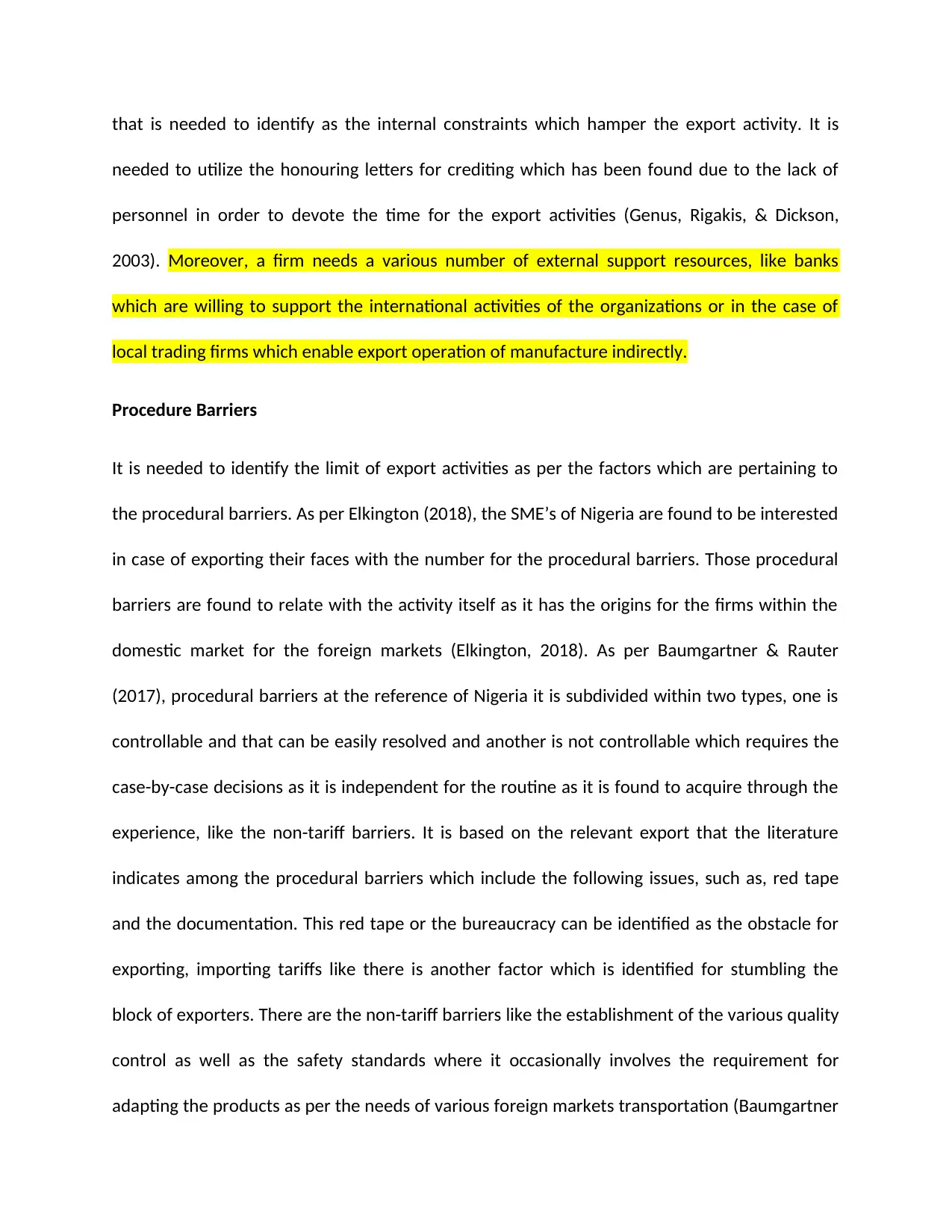
that is needed to identify as the internal constraints which hamper the export activity. It is
needed to utilize the honouring letters for crediting which has been found due to the lack of
personnel in order to devote the time for the export activities (Genus, Rigakis, & Dickson,
2003). Moreover, a firm needs a various number of external support resources, like banks
which are willing to support the international activities of the organizations or in the case of
local trading firms which enable export operation of manufacture indirectly.
Procedure Barriers
It is needed to identify the limit of export activities as per the factors which are pertaining to
the procedural barriers. As per Elkington (2018), the SME’s of Nigeria are found to be interested
in case of exporting their faces with the number for the procedural barriers. Those procedural
barriers are found to relate with the activity itself as it has the origins for the firms within the
domestic market for the foreign markets (Elkington, 2018). As per Baumgartner & Rauter
(2017), procedural barriers at the reference of Nigeria it is subdivided within two types, one is
controllable and that can be easily resolved and another is not controllable which requires the
case-by-case decisions as it is independent for the routine as it is found to acquire through the
experience, like the non-tariff barriers. It is based on the relevant export that the literature
indicates among the procedural barriers which include the following issues, such as, red tape
and the documentation. This red tape or the bureaucracy can be identified as the obstacle for
exporting, importing tariffs like there is another factor which is identified for stumbling the
block of exporters. There are the non-tariff barriers like the establishment of the various quality
control as well as the safety standards where it occasionally involves the requirement for
adapting the products as per the needs of various foreign markets transportation (Baumgartner
needed to utilize the honouring letters for crediting which has been found due to the lack of
personnel in order to devote the time for the export activities (Genus, Rigakis, & Dickson,
2003). Moreover, a firm needs a various number of external support resources, like banks
which are willing to support the international activities of the organizations or in the case of
local trading firms which enable export operation of manufacture indirectly.
Procedure Barriers
It is needed to identify the limit of export activities as per the factors which are pertaining to
the procedural barriers. As per Elkington (2018), the SME’s of Nigeria are found to be interested
in case of exporting their faces with the number for the procedural barriers. Those procedural
barriers are found to relate with the activity itself as it has the origins for the firms within the
domestic market for the foreign markets (Elkington, 2018). As per Baumgartner & Rauter
(2017), procedural barriers at the reference of Nigeria it is subdivided within two types, one is
controllable and that can be easily resolved and another is not controllable which requires the
case-by-case decisions as it is independent for the routine as it is found to acquire through the
experience, like the non-tariff barriers. It is based on the relevant export that the literature
indicates among the procedural barriers which include the following issues, such as, red tape
and the documentation. This red tape or the bureaucracy can be identified as the obstacle for
exporting, importing tariffs like there is another factor which is identified for stumbling the
block of exporters. There are the non-tariff barriers like the establishment of the various quality
control as well as the safety standards where it occasionally involves the requirement for
adapting the products as per the needs of various foreign markets transportation (Baumgartner

& Rauter, 2017). There are also some distribution difficulties for the foreign markets as well as
the domestic markets as it is found to limit the ability for the exporters. There is the difficulty
for finding the trustworthy if distributor for Nigeria.
Exogenous Barriers
It is finally identified that as per exogenous barriers which are needed to obtain the uncertainty
of the international markets. It is largely due to the activities for the other players within the
market and mainly it is due to the activities for the other players within the market, like the
competitors, supply and demand as well as the foreign governments. It means there are
variable transcend which controls the exporting company. There are the factors, like the
powerful competition as it can be faced the foreign markets which have been cited at this
context. There is the political instability for the foreign markets as well as the risk of losing the
money (Fransen, Verlegh, Kirmani, & Smit, 2015). There is the study which is highlighted by the
dynamic nature for the barriers for exporting. So it has been identified consistently that the
variations within the barrier as it perceptions by the export stage within Nigeria.
Need for internationalization
According to the viewpoint of (Peng, M. W. 2017), as there are a lot of barriers in Nigerian small
and medium scale agribusiness enterprises, it has been planning for internationalization. The
researcher has mentioned some of the barriers like financial barriers, human resource barriers,
and specification of the firm as well as industry (Peng, M. W. 2017). It is evident that if the
country is already rich in agriculture production then Nigerian enterprises will face intense
competition from those SMEs and hence it will become one of the barriers to making entry. In a
the domestic markets as it is found to limit the ability for the exporters. There is the difficulty
for finding the trustworthy if distributor for Nigeria.
Exogenous Barriers
It is finally identified that as per exogenous barriers which are needed to obtain the uncertainty
of the international markets. It is largely due to the activities for the other players within the
market and mainly it is due to the activities for the other players within the market, like the
competitors, supply and demand as well as the foreign governments. It means there are
variable transcend which controls the exporting company. There are the factors, like the
powerful competition as it can be faced the foreign markets which have been cited at this
context. There is the political instability for the foreign markets as well as the risk of losing the
money (Fransen, Verlegh, Kirmani, & Smit, 2015). There is the study which is highlighted by the
dynamic nature for the barriers for exporting. So it has been identified consistently that the
variations within the barrier as it perceptions by the export stage within Nigeria.
Need for internationalization
According to the viewpoint of (Peng, M. W. 2017), as there are a lot of barriers in Nigerian small
and medium scale agribusiness enterprises, it has been planning for internationalization. The
researcher has mentioned some of the barriers like financial barriers, human resource barriers,
and specification of the firm as well as industry (Peng, M. W. 2017). It is evident that if the
country is already rich in agriculture production then Nigerian enterprises will face intense
competition from those SMEs and hence it will become one of the barriers to making entry. In a
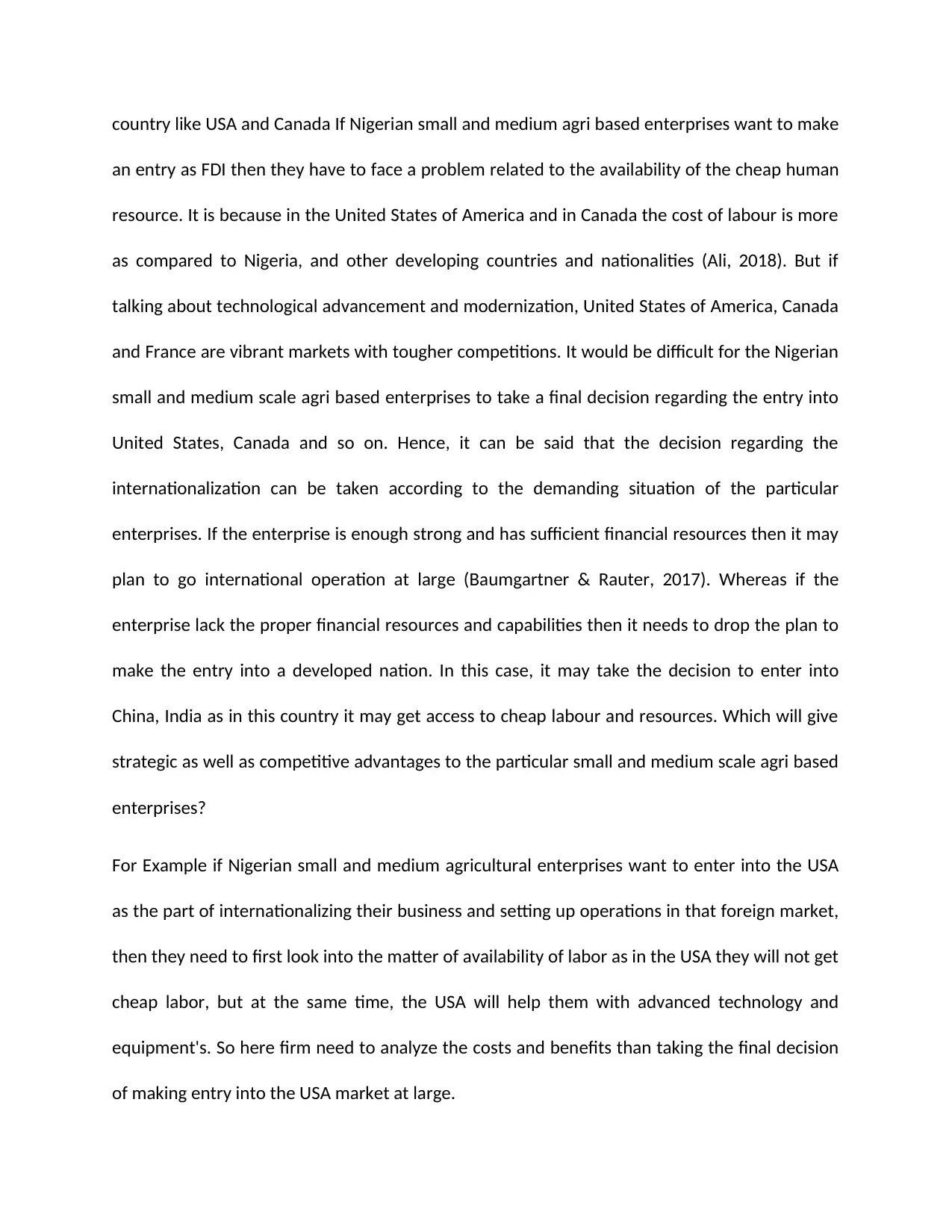
country like USA and Canada If Nigerian small and medium agri based enterprises want to make
an entry as FDI then they have to face a problem related to the availability of the cheap human
resource. It is because in the United States of America and in Canada the cost of labour is more
as compared to Nigeria, and other developing countries and nationalities (Ali, 2018). But if
talking about technological advancement and modernization, United States of America, Canada
and France are vibrant markets with tougher competitions. It would be difficult for the Nigerian
small and medium scale agri based enterprises to take a final decision regarding the entry into
United States, Canada and so on. Hence, it can be said that the decision regarding the
internationalization can be taken according to the demanding situation of the particular
enterprises. If the enterprise is enough strong and has sufficient financial resources then it may
plan to go international operation at large (Baumgartner & Rauter, 2017). Whereas if the
enterprise lack the proper financial resources and capabilities then it needs to drop the plan to
make the entry into a developed nation. In this case, it may take the decision to enter into
China, India as in this country it may get access to cheap labour and resources. Which will give
strategic as well as competitive advantages to the particular small and medium scale agri based
enterprises?
For Example if Nigerian small and medium agricultural enterprises want to enter into the USA
as the part of internationalizing their business and setting up operations in that foreign market,
then they need to first look into the matter of availability of labor as in the USA they will not get
cheap labor, but at the same time, the USA will help them with advanced technology and
equipment's. So here firm need to analyze the costs and benefits than taking the final decision
of making entry into the USA market at large.
an entry as FDI then they have to face a problem related to the availability of the cheap human
resource. It is because in the United States of America and in Canada the cost of labour is more
as compared to Nigeria, and other developing countries and nationalities (Ali, 2018). But if
talking about technological advancement and modernization, United States of America, Canada
and France are vibrant markets with tougher competitions. It would be difficult for the Nigerian
small and medium scale agri based enterprises to take a final decision regarding the entry into
United States, Canada and so on. Hence, it can be said that the decision regarding the
internationalization can be taken according to the demanding situation of the particular
enterprises. If the enterprise is enough strong and has sufficient financial resources then it may
plan to go international operation at large (Baumgartner & Rauter, 2017). Whereas if the
enterprise lack the proper financial resources and capabilities then it needs to drop the plan to
make the entry into a developed nation. In this case, it may take the decision to enter into
China, India as in this country it may get access to cheap labour and resources. Which will give
strategic as well as competitive advantages to the particular small and medium scale agri based
enterprises?
For Example if Nigerian small and medium agricultural enterprises want to enter into the USA
as the part of internationalizing their business and setting up operations in that foreign market,
then they need to first look into the matter of availability of labor as in the USA they will not get
cheap labor, but at the same time, the USA will help them with advanced technology and
equipment's. So here firm need to analyze the costs and benefits than taking the final decision
of making entry into the USA market at large.
Paraphrase This Document
Need a fresh take? Get an instant paraphrase of this document with our AI Paraphraser

According to the viewpoint (Ibrahim 2017) Nigerian small and medium scale agribusiness
enterprises may use the location advantage theory while planning to go international. The
location-specific advantage is thus considered as the ability for the individual, company as well
as the economy for conducting better activity related to the location. It is because it will help
them in analyzing the strategic as well as a competitive advantage in an effective manner
(Ibrahim et al., 2017). The research conclusion of the researcher highlights that Location
advantage theory helps the organization is going to international operation successfully.
Additionally, as per the Okpara and Pamela (2012), it has been demonstrated that In case of
SME, there is an enormous contribution for creating the employment in Nigeria (Walsh &
Dodds, 2017). It has been further found that in SME there is 20 to 45 per cent of the full-time
business. Moreover, there is 30 to 50 per cent for the rural household earnings (Brea Solís,‐
Casadesus Masanell, & Grifell Tatjé, 2015). In some cases, the performance for SME will be low‐ ‐
as per the expectation. It would produce the sound in case of improving within the bigger
economy. In South Africa, SMEs are found that 80 percentages of the formal business and other
95 per cent of the overall business division are included. There is 46 per cent for financial
activities including 84 per cent of private labour are included in this sector (Chan & Huff, 2014).
Conceptual framework
The conceptual framework has been set up in the below figure 1 and figures 2 with the specific
components as they impact in case of Nigerian agricultural SMEs for the export performance.
Therefore, there is the conceptual framework hypothesizes that there is the commitment for
the institutional components in order to have the impact over the entrepreneurial orientation
enterprises may use the location advantage theory while planning to go international. The
location-specific advantage is thus considered as the ability for the individual, company as well
as the economy for conducting better activity related to the location. It is because it will help
them in analyzing the strategic as well as a competitive advantage in an effective manner
(Ibrahim et al., 2017). The research conclusion of the researcher highlights that Location
advantage theory helps the organization is going to international operation successfully.
Additionally, as per the Okpara and Pamela (2012), it has been demonstrated that In case of
SME, there is an enormous contribution for creating the employment in Nigeria (Walsh &
Dodds, 2017). It has been further found that in SME there is 20 to 45 per cent of the full-time
business. Moreover, there is 30 to 50 per cent for the rural household earnings (Brea Solís,‐
Casadesus Masanell, & Grifell Tatjé, 2015). In some cases, the performance for SME will be low‐ ‐
as per the expectation. It would produce the sound in case of improving within the bigger
economy. In South Africa, SMEs are found that 80 percentages of the formal business and other
95 per cent of the overall business division are included. There is 46 per cent for financial
activities including 84 per cent of private labour are included in this sector (Chan & Huff, 2014).
Conceptual framework
The conceptual framework has been set up in the below figure 1 and figures 2 with the specific
components as they impact in case of Nigerian agricultural SMEs for the export performance.
Therefore, there is the conceptual framework hypothesizes that there is the commitment for
the institutional components in order to have the impact over the entrepreneurial orientation
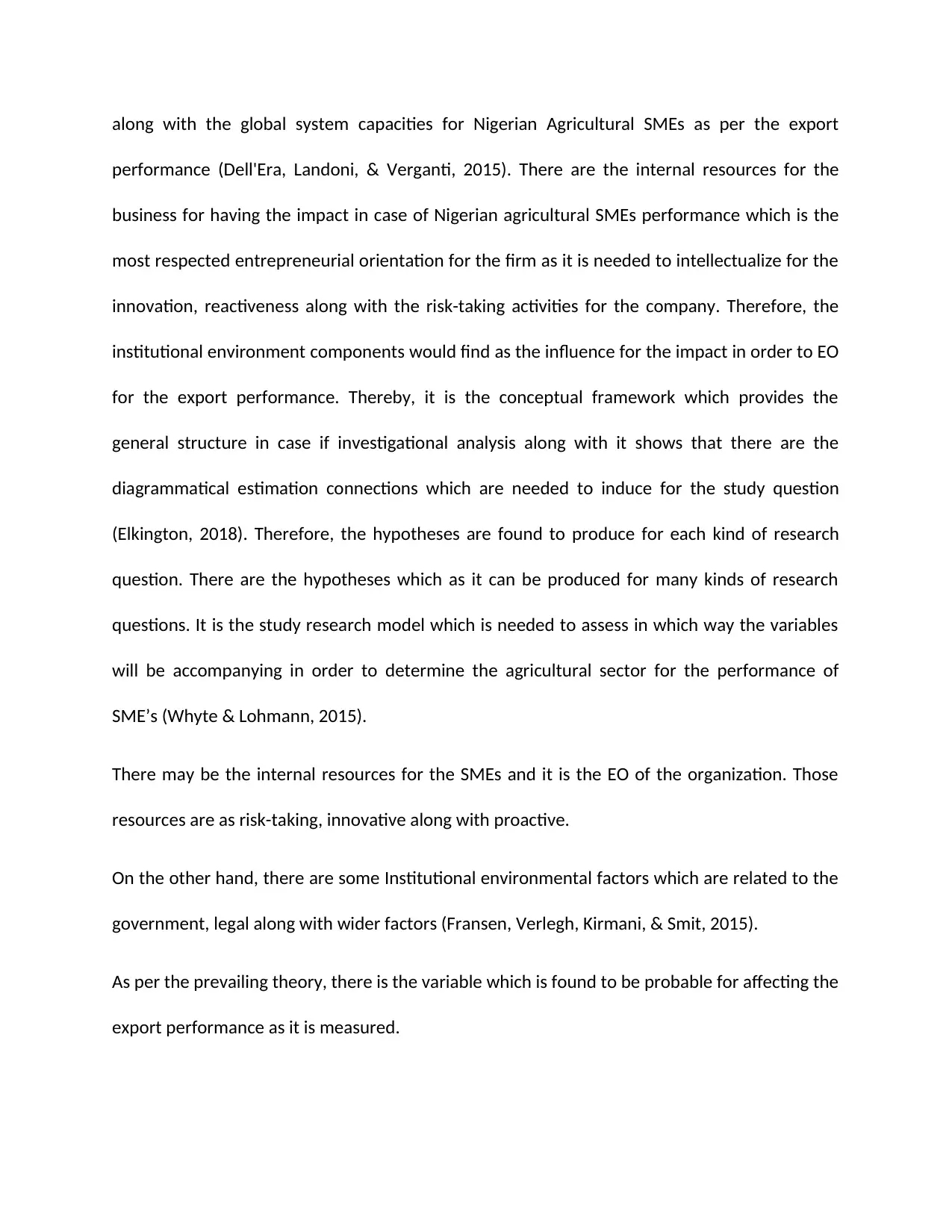
along with the global system capacities for Nigerian Agricultural SMEs as per the export
performance (Dell'Era, Landoni, & Verganti, 2015). There are the internal resources for the
business for having the impact in case of Nigerian agricultural SMEs performance which is the
most respected entrepreneurial orientation for the firm as it is needed to intellectualize for the
innovation, reactiveness along with the risk-taking activities for the company. Therefore, the
institutional environment components would find as the influence for the impact in order to EO
for the export performance. Thereby, it is the conceptual framework which provides the
general structure in case if investigational analysis along with it shows that there are the
diagrammatical estimation connections which are needed to induce for the study question
(Elkington, 2018). Therefore, the hypotheses are found to produce for each kind of research
question. There are the hypotheses which as it can be produced for many kinds of research
questions. It is the study research model which is needed to assess in which way the variables
will be accompanying in order to determine the agricultural sector for the performance of
SME’s (Whyte & Lohmann, 2015).
There may be the internal resources for the SMEs and it is the EO of the organization. Those
resources are as risk-taking, innovative along with proactive.
On the other hand, there are some Institutional environmental factors which are related to the
government, legal along with wider factors (Fransen, Verlegh, Kirmani, & Smit, 2015).
As per the prevailing theory, there is the variable which is found to be probable for affecting the
export performance as it is measured.
performance (Dell'Era, Landoni, & Verganti, 2015). There are the internal resources for the
business for having the impact in case of Nigerian agricultural SMEs performance which is the
most respected entrepreneurial orientation for the firm as it is needed to intellectualize for the
innovation, reactiveness along with the risk-taking activities for the company. Therefore, the
institutional environment components would find as the influence for the impact in order to EO
for the export performance. Thereby, it is the conceptual framework which provides the
general structure in case if investigational analysis along with it shows that there are the
diagrammatical estimation connections which are needed to induce for the study question
(Elkington, 2018). Therefore, the hypotheses are found to produce for each kind of research
question. There are the hypotheses which as it can be produced for many kinds of research
questions. It is the study research model which is needed to assess in which way the variables
will be accompanying in order to determine the agricultural sector for the performance of
SME’s (Whyte & Lohmann, 2015).
There may be the internal resources for the SMEs and it is the EO of the organization. Those
resources are as risk-taking, innovative along with proactive.
On the other hand, there are some Institutional environmental factors which are related to the
government, legal along with wider factors (Fransen, Verlegh, Kirmani, & Smit, 2015).
As per the prevailing theory, there is the variable which is found to be probable for affecting the
export performance as it is measured.
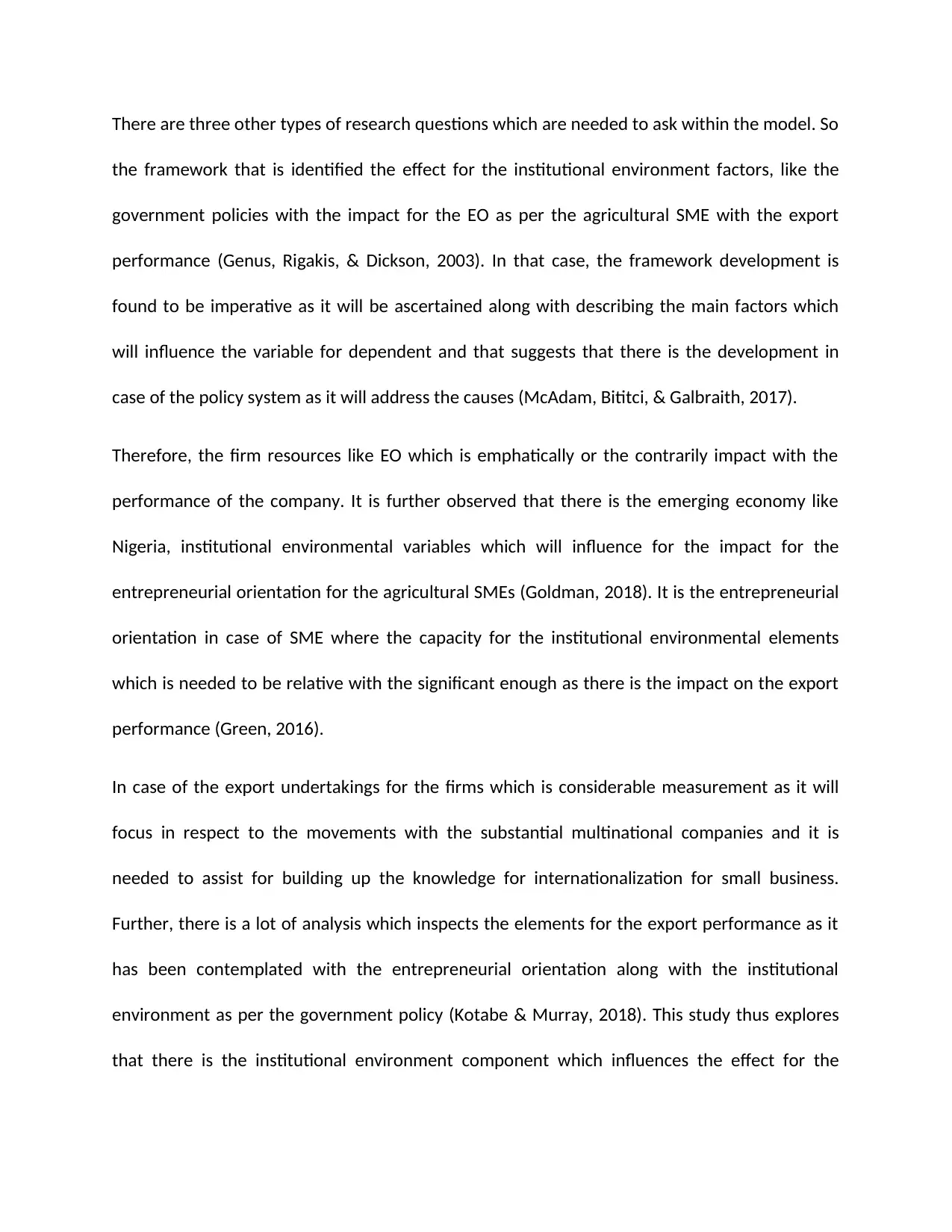
There are three other types of research questions which are needed to ask within the model. So
the framework that is identified the effect for the institutional environment factors, like the
government policies with the impact for the EO as per the agricultural SME with the export
performance (Genus, Rigakis, & Dickson, 2003). In that case, the framework development is
found to be imperative as it will be ascertained along with describing the main factors which
will influence the variable for dependent and that suggests that there is the development in
case of the policy system as it will address the causes (McAdam, Bititci, & Galbraith, 2017).
Therefore, the firm resources like EO which is emphatically or the contrarily impact with the
performance of the company. It is further observed that there is the emerging economy like
Nigeria, institutional environmental variables which will influence for the impact for the
entrepreneurial orientation for the agricultural SMEs (Goldman, 2018). It is the entrepreneurial
orientation in case of SME where the capacity for the institutional environmental elements
which is needed to be relative with the significant enough as there is the impact on the export
performance (Green, 2016).
In case of the export undertakings for the firms which is considerable measurement as it will
focus in respect to the movements with the substantial multinational companies and it is
needed to assist for building up the knowledge for internationalization for small business.
Further, there is a lot of analysis which inspects the elements for the export performance as it
has been contemplated with the entrepreneurial orientation along with the institutional
environment as per the government policy (Kotabe & Murray, 2018). This study thus explores
that there is the institutional environment component which influences the effect for the
the framework that is identified the effect for the institutional environment factors, like the
government policies with the impact for the EO as per the agricultural SME with the export
performance (Genus, Rigakis, & Dickson, 2003). In that case, the framework development is
found to be imperative as it will be ascertained along with describing the main factors which
will influence the variable for dependent and that suggests that there is the development in
case of the policy system as it will address the causes (McAdam, Bititci, & Galbraith, 2017).
Therefore, the firm resources like EO which is emphatically or the contrarily impact with the
performance of the company. It is further observed that there is the emerging economy like
Nigeria, institutional environmental variables which will influence for the impact for the
entrepreneurial orientation for the agricultural SMEs (Goldman, 2018). It is the entrepreneurial
orientation in case of SME where the capacity for the institutional environmental elements
which is needed to be relative with the significant enough as there is the impact on the export
performance (Green, 2016).
In case of the export undertakings for the firms which is considerable measurement as it will
focus in respect to the movements with the substantial multinational companies and it is
needed to assist for building up the knowledge for internationalization for small business.
Further, there is a lot of analysis which inspects the elements for the export performance as it
has been contemplated with the entrepreneurial orientation along with the institutional
environment as per the government policy (Kotabe & Murray, 2018). This study thus explores
that there is the institutional environment component which influences the effect for the
Secure Best Marks with AI Grader
Need help grading? Try our AI Grader for instant feedback on your assignments.
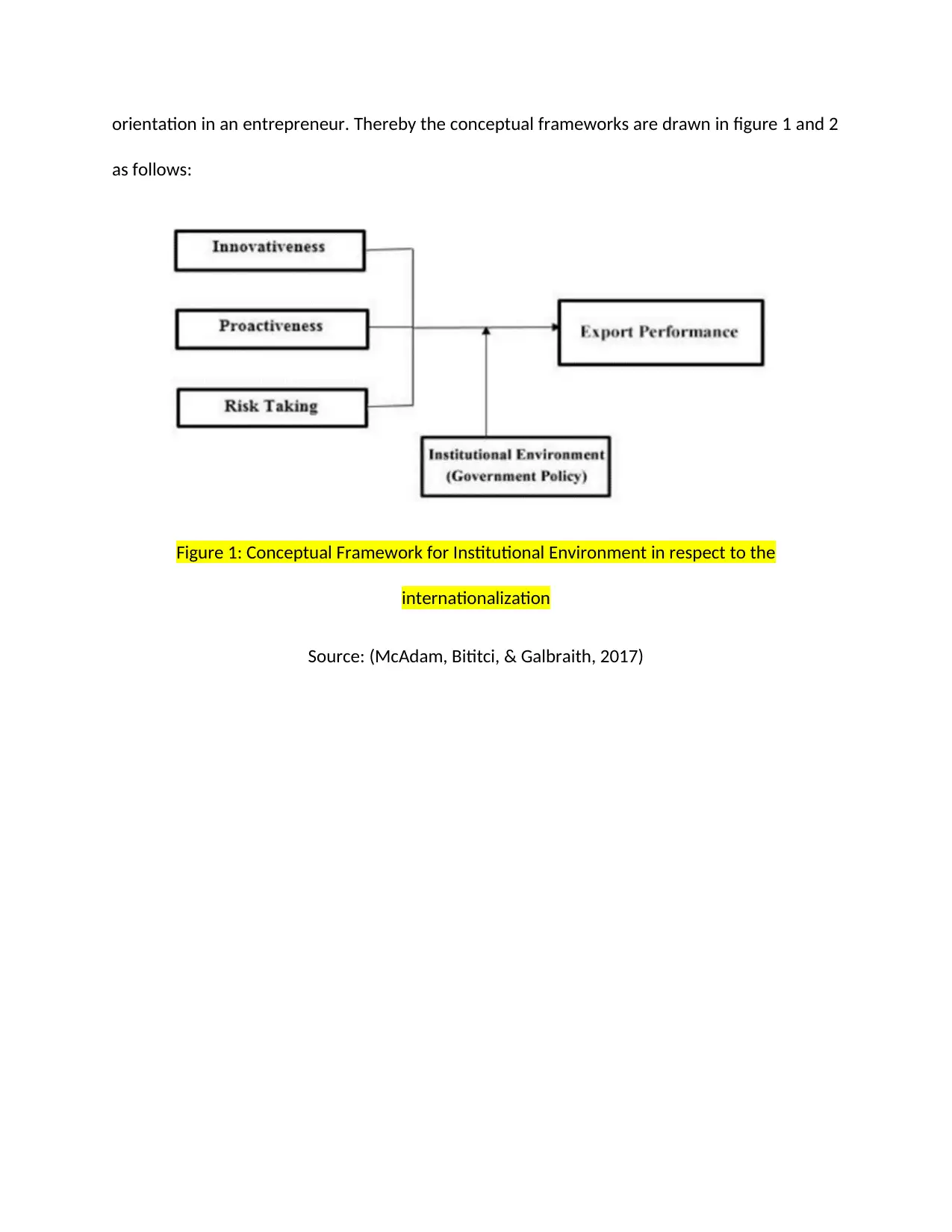
orientation in an entrepreneur. Thereby the conceptual frameworks are drawn in figure 1 and 2
as follows:
Figure 1: Conceptual Framework for Institutional Environment in respect to the
internationalization
Source: (McAdam, Bititci, & Galbraith, 2017)
as follows:
Figure 1: Conceptual Framework for Institutional Environment in respect to the
internationalization
Source: (McAdam, Bititci, & Galbraith, 2017)
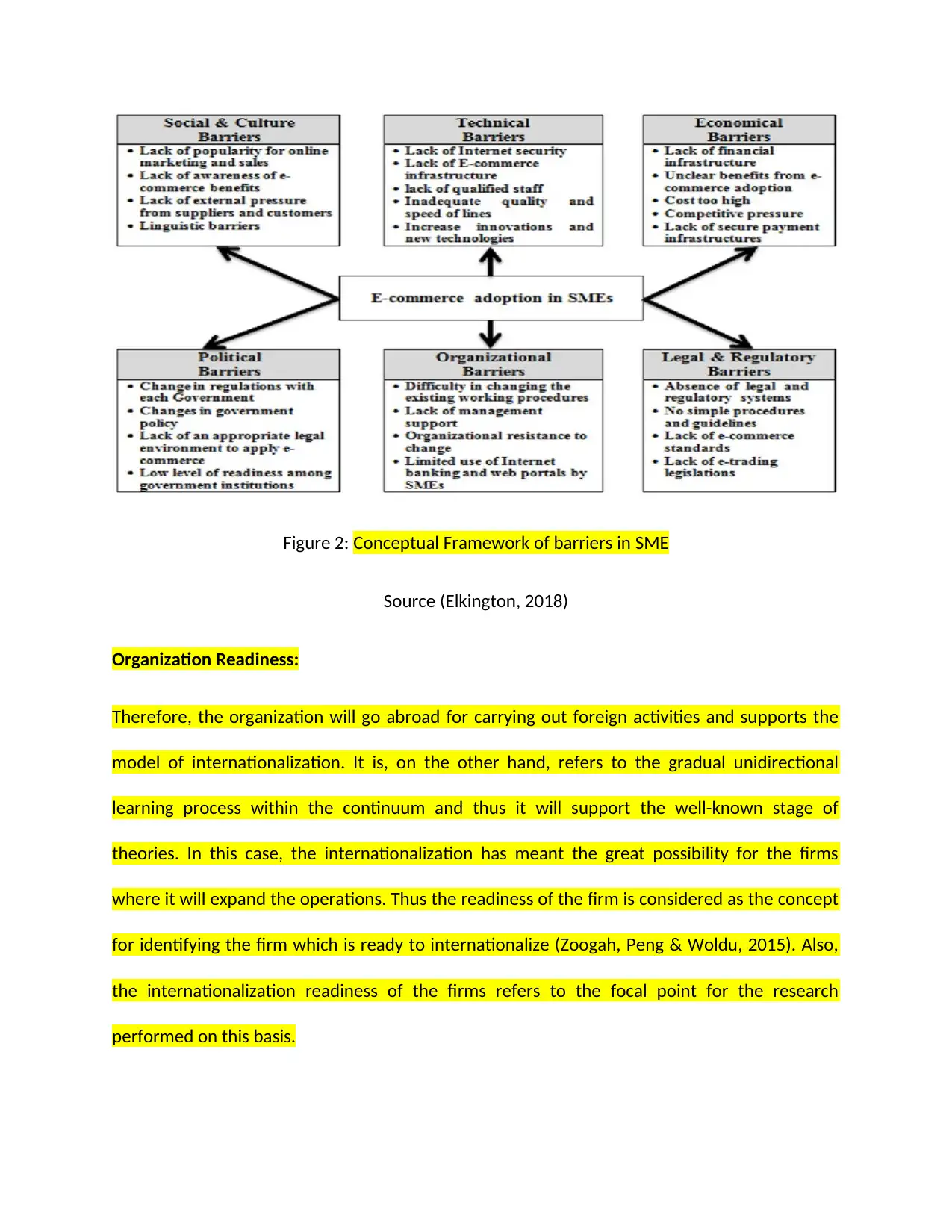
Figure 2: Conceptual Framework of barriers in SME
Source (Elkington, 2018)
Organization Readiness:
Therefore, the organization will go abroad for carrying out foreign activities and supports the
model of internationalization. It is, on the other hand, refers to the gradual unidirectional
learning process within the continuum and thus it will support the well-known stage of
theories. In this case, the internationalization has meant the great possibility for the firms
where it will expand the operations. Thus the readiness of the firm is considered as the concept
for identifying the firm which is ready to internationalize (Zoogah, Peng & Woldu, 2015). Also,
the internationalization readiness of the firms refers to the focal point for the research
performed on this basis.
Source (Elkington, 2018)
Organization Readiness:
Therefore, the organization will go abroad for carrying out foreign activities and supports the
model of internationalization. It is, on the other hand, refers to the gradual unidirectional
learning process within the continuum and thus it will support the well-known stage of
theories. In this case, the internationalization has meant the great possibility for the firms
where it will expand the operations. Thus the readiness of the firm is considered as the concept
for identifying the firm which is ready to internationalize (Zoogah, Peng & Woldu, 2015). Also,
the internationalization readiness of the firms refers to the focal point for the research
performed on this basis.
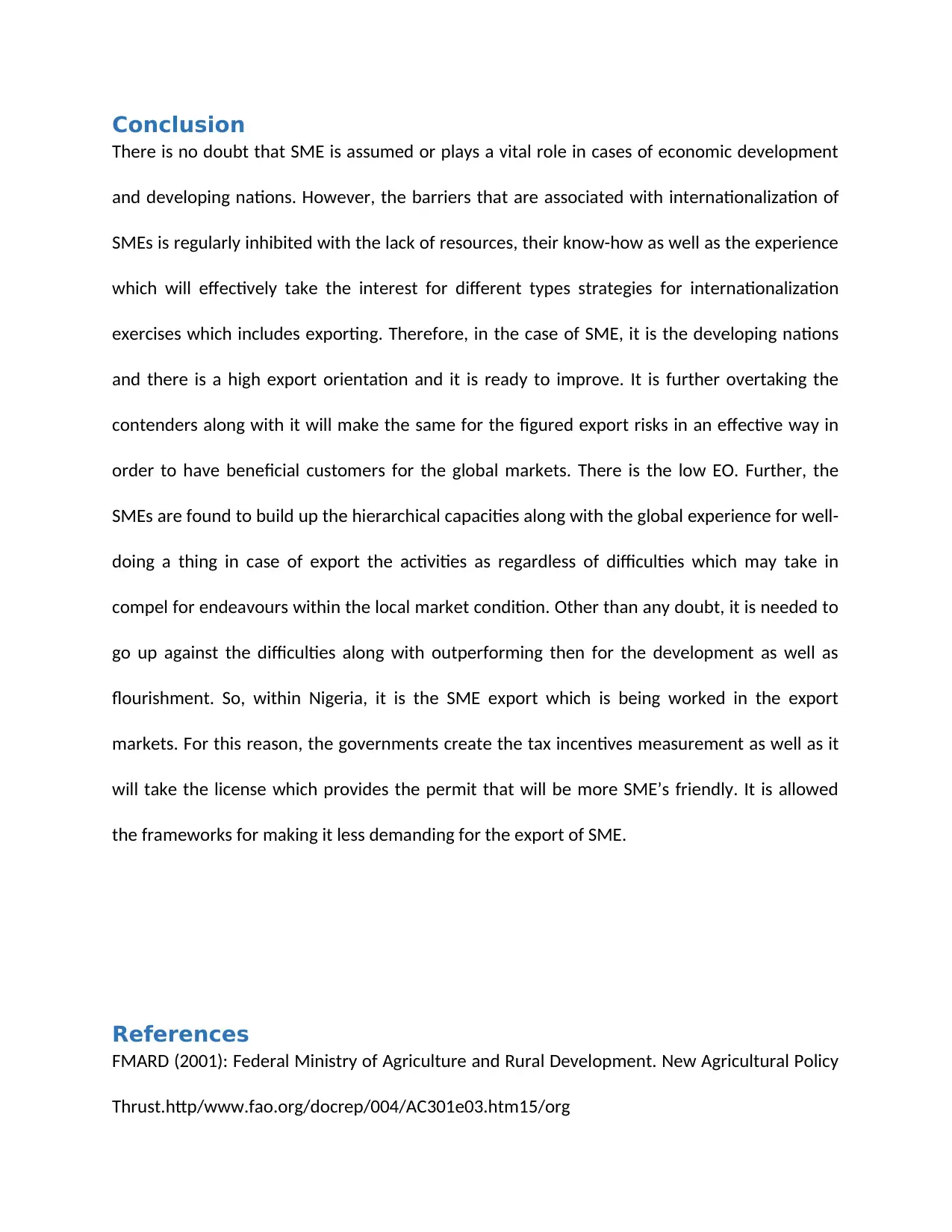
Conclusion
There is no doubt that SME is assumed or plays a vital role in cases of economic development
and developing nations. However, the barriers that are associated with internationalization of
SMEs is regularly inhibited with the lack of resources, their know-how as well as the experience
which will effectively take the interest for different types strategies for internationalization
exercises which includes exporting. Therefore, in the case of SME, it is the developing nations
and there is a high export orientation and it is ready to improve. It is further overtaking the
contenders along with it will make the same for the figured export risks in an effective way in
order to have beneficial customers for the global markets. There is the low EO. Further, the
SMEs are found to build up the hierarchical capacities along with the global experience for well-
doing a thing in case of export the activities as regardless of difficulties which may take in
compel for endeavours within the local market condition. Other than any doubt, it is needed to
go up against the difficulties along with outperforming then for the development as well as
flourishment. So, within Nigeria, it is the SME export which is being worked in the export
markets. For this reason, the governments create the tax incentives measurement as well as it
will take the license which provides the permit that will be more SME’s friendly. It is allowed
the frameworks for making it less demanding for the export of SME.
References
FMARD (2001): Federal Ministry of Agriculture and Rural Development. New Agricultural Policy
Thrust.http/www.fao.org/docrep/004/AC301e03.htm15/org
There is no doubt that SME is assumed or plays a vital role in cases of economic development
and developing nations. However, the barriers that are associated with internationalization of
SMEs is regularly inhibited with the lack of resources, their know-how as well as the experience
which will effectively take the interest for different types strategies for internationalization
exercises which includes exporting. Therefore, in the case of SME, it is the developing nations
and there is a high export orientation and it is ready to improve. It is further overtaking the
contenders along with it will make the same for the figured export risks in an effective way in
order to have beneficial customers for the global markets. There is the low EO. Further, the
SMEs are found to build up the hierarchical capacities along with the global experience for well-
doing a thing in case of export the activities as regardless of difficulties which may take in
compel for endeavours within the local market condition. Other than any doubt, it is needed to
go up against the difficulties along with outperforming then for the development as well as
flourishment. So, within Nigeria, it is the SME export which is being worked in the export
markets. For this reason, the governments create the tax incentives measurement as well as it
will take the license which provides the permit that will be more SME’s friendly. It is allowed
the frameworks for making it less demanding for the export of SME.
References
FMARD (2001): Federal Ministry of Agriculture and Rural Development. New Agricultural Policy
Thrust.http/www.fao.org/docrep/004/AC301e03.htm15/org
Paraphrase This Document
Need a fresh take? Get an instant paraphrase of this document with our AI Paraphraser

Peng, M. W. (2016). Global business. Cengage Learning.
Meyer, K., & Peng, M. W. (2016). International business. Cengage Learning.
Adewumi, B. A. (2008a): Fruit Production and Processing. Option for Rural Industrialization and
Poverty Alleviation in Nigeria. Book Project of the Alexander Vom Itumboldt Foundation Pg. 43-
53
Teece, D. J., Pisano, G., & Shuen, A. (1997). Dynamic capabilities and strategic management.
Strategic management journal, 18(7), 509-533.
Bijaoui, I. (2016). SMEs in an Era of Globalization: International Business and Market Strategies.
Springer.
Ajayi, B. (2016). The impact of entrepreneurial orientation and networking capabilities on the
export performance of Nigerian agricultural SMEs. Journal of Entrepreneurship and Innovation
in Emerging Economies, 2(1), 1-23.
Zoogah, D. B., Peng, M. W., & Woldu, H. (2015). Institutions, resources, and organizational
effectiveness in Africa. Academy of Management Perspectives, 29(1), 7-31.
Ibrahim, M. I., Keat, O. Y., & Abdul-Rani, S. H. B. (2017). GOVERNMENT SUPPORT POLICY AS A
POTENTIAL MODERATOR ON THE RELATIONSHIP BETWEEN ENTREPRENEURIAL ORIENTATION,
CONTEMPORARY MARKETING AND SMES PERFORMANCE IN NIGERIA A PROPOSED
FRAMEWORK. Kuwait Chapter of the Arabian Journal of Business and Management Review,
6(10), 32-42.
Meyer, K., & Peng, M. W. (2016). International business. Cengage Learning.
Adewumi, B. A. (2008a): Fruit Production and Processing. Option for Rural Industrialization and
Poverty Alleviation in Nigeria. Book Project of the Alexander Vom Itumboldt Foundation Pg. 43-
53
Teece, D. J., Pisano, G., & Shuen, A. (1997). Dynamic capabilities and strategic management.
Strategic management journal, 18(7), 509-533.
Bijaoui, I. (2016). SMEs in an Era of Globalization: International Business and Market Strategies.
Springer.
Ajayi, B. (2016). The impact of entrepreneurial orientation and networking capabilities on the
export performance of Nigerian agricultural SMEs. Journal of Entrepreneurship and Innovation
in Emerging Economies, 2(1), 1-23.
Zoogah, D. B., Peng, M. W., & Woldu, H. (2015). Institutions, resources, and organizational
effectiveness in Africa. Academy of Management Perspectives, 29(1), 7-31.
Ibrahim, M. I., Keat, O. Y., & Abdul-Rani, S. H. B. (2017). GOVERNMENT SUPPORT POLICY AS A
POTENTIAL MODERATOR ON THE RELATIONSHIP BETWEEN ENTREPRENEURIAL ORIENTATION,
CONTEMPORARY MARKETING AND SMES PERFORMANCE IN NIGERIA A PROPOSED
FRAMEWORK. Kuwait Chapter of the Arabian Journal of Business and Management Review,
6(10), 32-42.
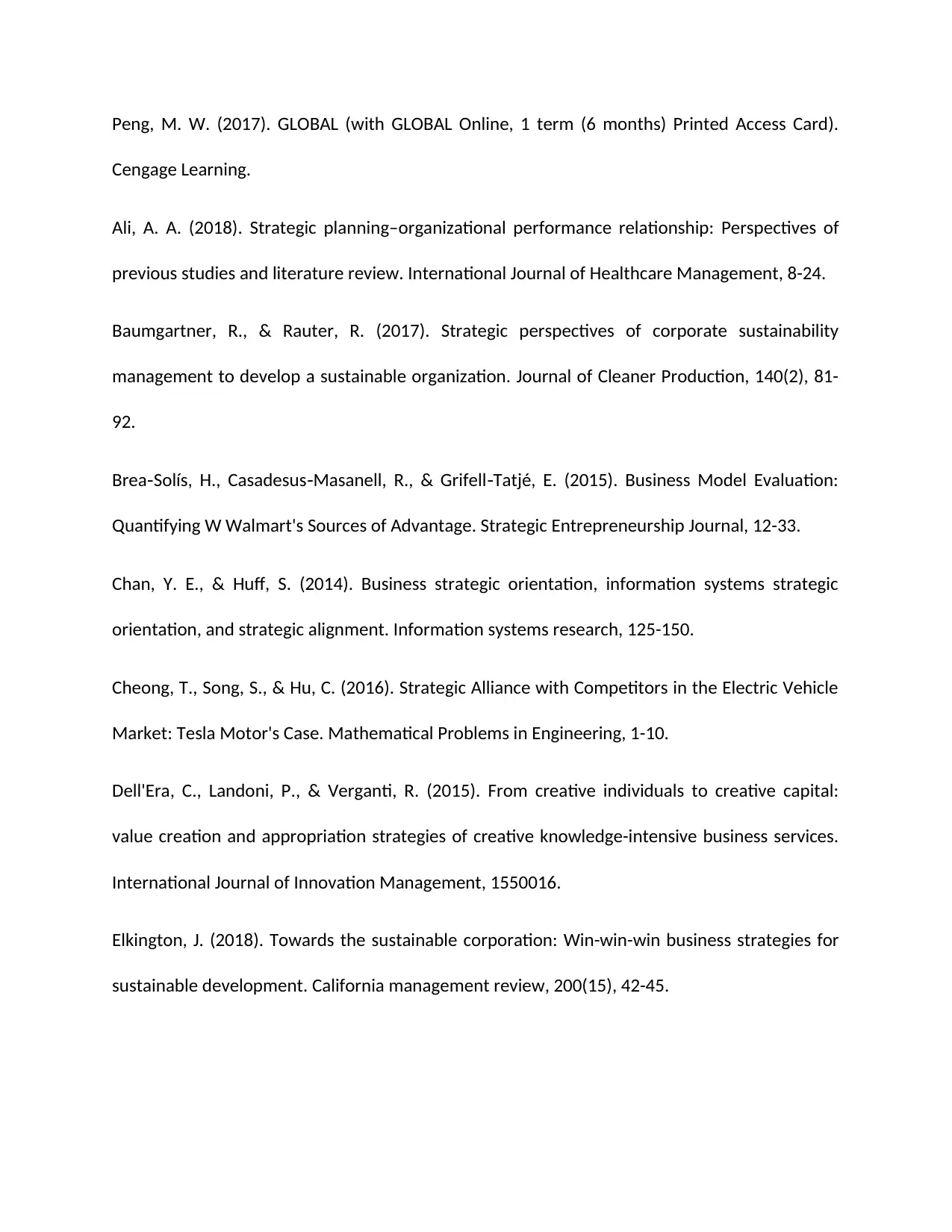
Peng, M. W. (2017). GLOBAL (with GLOBAL Online, 1 term (6 months) Printed Access Card).
Cengage Learning.
Ali, A. A. (2018). Strategic planning–organizational performance relationship: Perspectives of
previous studies and literature review. International Journal of Healthcare Management, 8-24.
Baumgartner, R., & Rauter, R. (2017). Strategic perspectives of corporate sustainability
management to develop a sustainable organization. Journal of Cleaner Production, 140(2), 81-
92.
Brea Solís, H., Casadesus Masanell, R., & Grifell Tatjé, E. (2015). Business Model Evaluation:‐ ‐ ‐
Quantifying W Walmart's Sources of Advantage. Strategic Entrepreneurship Journal, 12-33.
Chan, Y. E., & Huff, S. (2014). Business strategic orientation, information systems strategic
orientation, and strategic alignment. Information systems research, 125-150.
Cheong, T., Song, S., & Hu, C. (2016). Strategic Alliance with Competitors in the Electric Vehicle
Market: Tesla Motor's Case. Mathematical Problems in Engineering, 1-10.
Dell'Era, C., Landoni, P., & Verganti, R. (2015). From creative individuals to creative capital:
value creation and appropriation strategies of creative knowledge-intensive business services.
International Journal of Innovation Management, 1550016.
Elkington, J. (2018). Towards the sustainable corporation: Win-win-win business strategies for
sustainable development. California management review, 200(15), 42-45.
Cengage Learning.
Ali, A. A. (2018). Strategic planning–organizational performance relationship: Perspectives of
previous studies and literature review. International Journal of Healthcare Management, 8-24.
Baumgartner, R., & Rauter, R. (2017). Strategic perspectives of corporate sustainability
management to develop a sustainable organization. Journal of Cleaner Production, 140(2), 81-
92.
Brea Solís, H., Casadesus Masanell, R., & Grifell Tatjé, E. (2015). Business Model Evaluation:‐ ‐ ‐
Quantifying W Walmart's Sources of Advantage. Strategic Entrepreneurship Journal, 12-33.
Chan, Y. E., & Huff, S. (2014). Business strategic orientation, information systems strategic
orientation, and strategic alignment. Information systems research, 125-150.
Cheong, T., Song, S., & Hu, C. (2016). Strategic Alliance with Competitors in the Electric Vehicle
Market: Tesla Motor's Case. Mathematical Problems in Engineering, 1-10.
Dell'Era, C., Landoni, P., & Verganti, R. (2015). From creative individuals to creative capital:
value creation and appropriation strategies of creative knowledge-intensive business services.
International Journal of Innovation Management, 1550016.
Elkington, J. (2018). Towards the sustainable corporation: Win-win-win business strategies for
sustainable development. California management review, 200(15), 42-45.
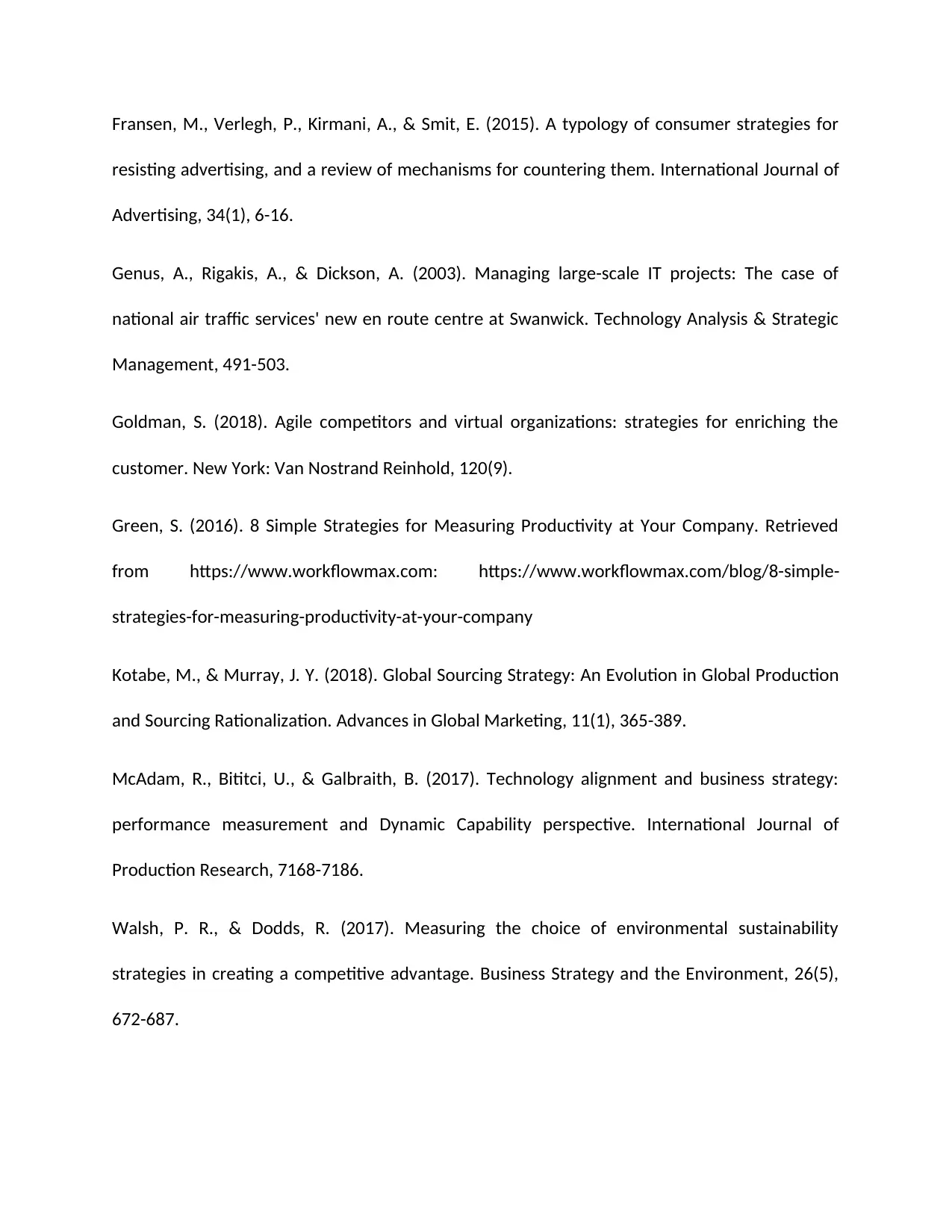
Fransen, M., Verlegh, P., Kirmani, A., & Smit, E. (2015). A typology of consumer strategies for
resisting advertising, and a review of mechanisms for countering them. International Journal of
Advertising, 34(1), 6-16.
Genus, A., Rigakis, A., & Dickson, A. (2003). Managing large-scale IT projects: The case of
national air traffic services' new en route centre at Swanwick. Technology Analysis & Strategic
Management, 491-503.
Goldman, S. (2018). Agile competitors and virtual organizations: strategies for enriching the
customer. New York: Van Nostrand Reinhold, 120(9).
Green, S. (2016). 8 Simple Strategies for Measuring Productivity at Your Company. Retrieved
from https://www.workflowmax.com: https://www.workflowmax.com/blog/8-simple-
strategies-for-measuring-productivity-at-your-company
Kotabe, M., & Murray, J. Y. (2018). Global Sourcing Strategy: An Evolution in Global Production
and Sourcing Rationalization. Advances in Global Marketing, 11(1), 365-389.
McAdam, R., Bititci, U., & Galbraith, B. (2017). Technology alignment and business strategy:
performance measurement and Dynamic Capability perspective. International Journal of
Production Research, 7168-7186.
Walsh, P. R., & Dodds, R. (2017). Measuring the choice of environmental sustainability
strategies in creating a competitive advantage. Business Strategy and the Environment, 26(5),
672-687.
resisting advertising, and a review of mechanisms for countering them. International Journal of
Advertising, 34(1), 6-16.
Genus, A., Rigakis, A., & Dickson, A. (2003). Managing large-scale IT projects: The case of
national air traffic services' new en route centre at Swanwick. Technology Analysis & Strategic
Management, 491-503.
Goldman, S. (2018). Agile competitors and virtual organizations: strategies for enriching the
customer. New York: Van Nostrand Reinhold, 120(9).
Green, S. (2016). 8 Simple Strategies for Measuring Productivity at Your Company. Retrieved
from https://www.workflowmax.com: https://www.workflowmax.com/blog/8-simple-
strategies-for-measuring-productivity-at-your-company
Kotabe, M., & Murray, J. Y. (2018). Global Sourcing Strategy: An Evolution in Global Production
and Sourcing Rationalization. Advances in Global Marketing, 11(1), 365-389.
McAdam, R., Bititci, U., & Galbraith, B. (2017). Technology alignment and business strategy:
performance measurement and Dynamic Capability perspective. International Journal of
Production Research, 7168-7186.
Walsh, P. R., & Dodds, R. (2017). Measuring the choice of environmental sustainability
strategies in creating a competitive advantage. Business Strategy and the Environment, 26(5),
672-687.
Secure Best Marks with AI Grader
Need help grading? Try our AI Grader for instant feedback on your assignments.
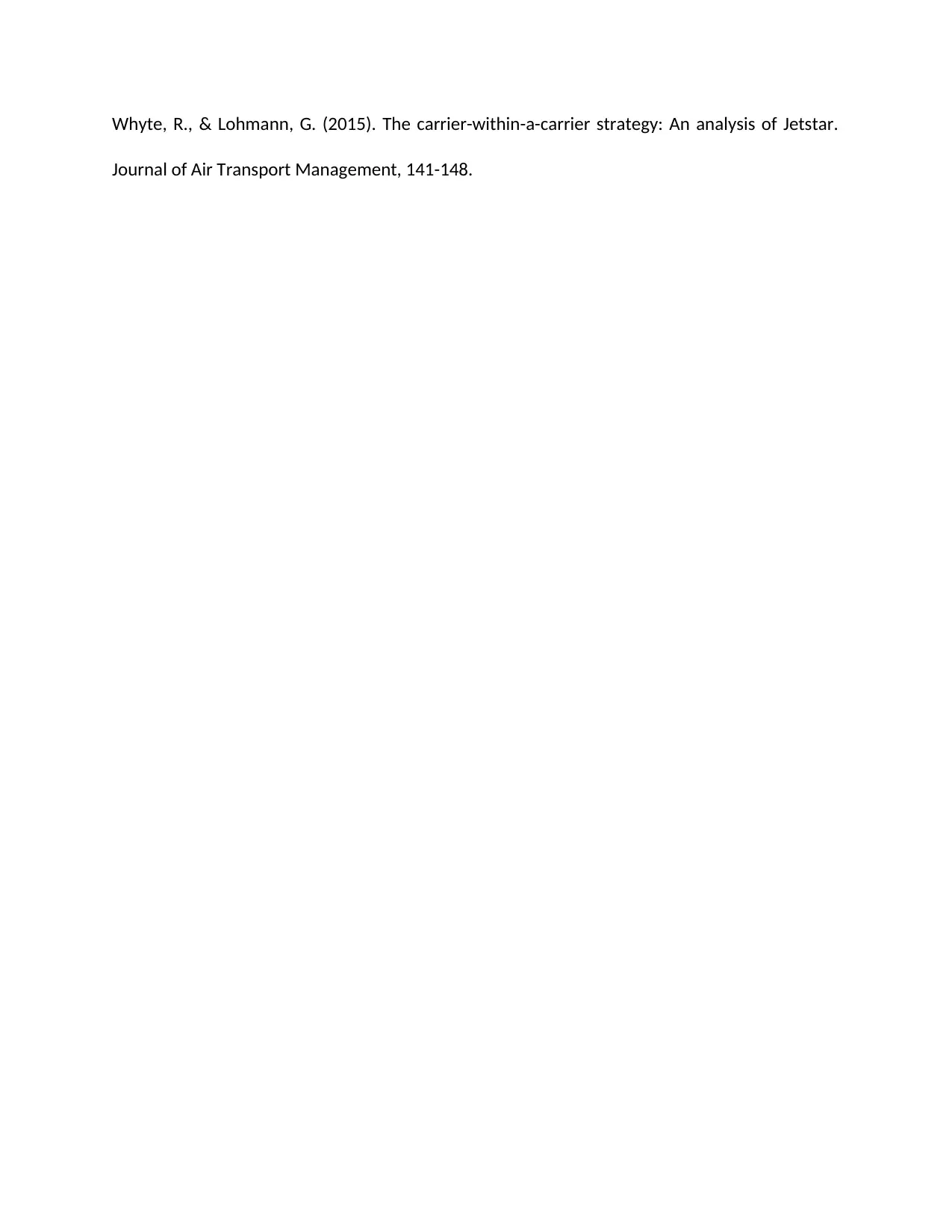
Whyte, R., & Lohmann, G. (2015). The carrier-within-a-carrier strategy: An analysis of Jetstar.
Journal of Air Transport Management, 141-148.
Journal of Air Transport Management, 141-148.
1 out of 20
Related Documents
Your All-in-One AI-Powered Toolkit for Academic Success.
+13062052269
info@desklib.com
Available 24*7 on WhatsApp / Email
![[object Object]](/_next/static/media/star-bottom.7253800d.svg)
Unlock your academic potential
© 2024 | Zucol Services PVT LTD | All rights reserved.





